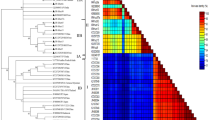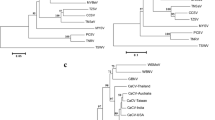Abstract
An isolate of Sugarcane mosaic virus causing mosaic disease in sugarcane cultivar CoSe 93232 from the north-eastern region of India was molecularly characterized. The size of the RNA was about 9.8 + 0.1 kbp on 1% agarose gel. Immuno-based polymerase chain reaction was performed to amplify the nucleocapsid protein gene with primer pair 5’-CGXATCGYTAZZATNNG-3’and 5’-GCTATGGGCAGATGCCC-3’ The nucleocapsid protein gene was cloned and sequenced. The length of the coat protein was 1330 nucleotides encoding 365 amino acids. This nucleotide amino acid sequence showed closest homology with SCMV-SC isolate from Australia (99%) followed by SCMV-A (USA, 97%), SCMV-BJ (China, 87%) and SCMV-MDB (USA, 80%). The sequence identity and phylogenetic relationship of the Indian virus isolate with characterized SCMV strains from Australia, USA, Egypt, Cameroon, China, South Africa and Congo indicated that this isolate belonged to Sugarcane mosaic potyvirus subgroup. This is the first molecular confirmation of SCMV from India.
Similar content being viewed by others
References
Donier, L.L., Shaw, J.G. andRhoads, R.E. (1987). Potyviral proteins share amino acid sequence homology with picorna, como and caulino viral proteins.Virology,146: 282–291.
Frenkel, M., Jilka, J., Shukla, D.D. andWard, C.W. (1992). Differentiation of potyviruses their strains by hybridization with the 3’ non-coding region of the viral genome.J. Virol. Methods, 36: 51–62.
Gillaspie, Jr.A.G., Mock, R.G. and Hearon, S.S. (1984). Status of identification of sugarcane mosaic virus strains world wide.Maize virus diseases Newsletter, 1: 30–32
Gopal, K. and Reddy, K.S. (1988). Studies on mosaic disease of sugarcane (Saccharum officinarum L.)Plant Pathol. News,6: 1–2.
Grunstein, M. and Hogness, D.S. (1975). Colony hybridization: a method for the isolation of cloned DNA that contain a specific gene.Proc. Natl. Acad. Sci, USA,72: 3691.
Harper, G., Ganesh, D., Thottappilly, G. and Hull, R. (1999). Detection of episomal banana streak badnavirus by IC-PCR.J. of Virological Methods,79: 1–8.
Harrison, N.A., Richardson, P.A., Jones, P., Tymon, A.M., EdenGreen, S.J. andMpunani, A.A. (1994). Comparative investigation of MLOs associated with Caribbean and African coconut lethal decline disease by DNA hybridization and PCR assays.Plant Disease,78: 507–511.
Hema, M., Sreenivasulu, P., Gopinath, K., Kiranmai, G. and Satynarayana, T. (1997). Partial characterization of a potyvirus causing mosaic disease of sugarcane in Andhra Pradesh.Indian J Virology, 13: 125–129.
Hema, M., Joseph, J., Gopinath, K., Sreenivasulu, P., and Savithri, H.S. (1999). Molecular characterization and interviral relationships of a flexuous filamentous virus causing mosaic disease of sugarcane (Saccharum officinarum L.) in India.Arch Virol.,144: 479–490.
Hema, M., Savithri, H.S. and Sreenivasulu, P. (2002). Taxonomic postion of sugarcane streak mosaic virus in the family Potyviridae.Arch. Virol.,147: 1997–2007.
Kondaiah, E. andNayudu, M.V. (1984). Sugarcane mosaic virus-H, a new record from India.Current Science,53: 273- 275.
Kondaiah, E. and Nayudu, M.V. (1985). Strain N-A new strain of sugarcane mosaic virus.Sugarcane,4: 11–14.
Mishra, M., Rao, G.P. and Upadhyaya, P.P. (1998). Identification and characterization of maize dwarf mosaic potyvirus in India.Indian J Virol.,14: 75–79.
Rao, G.P. (1998). Identification of sugarcane mosaic potyvirus on sorghum and bajra in India.Indian J. Virol.,14: 81–84.
Rao, G.P., Jain, R.K., Lim, H.S. and Ford, R.E. (1996a). Identification of sugarcane mosaic potyvirus infecting sudangrass in India(Abstract no. 514A).Review of Plant Pathology, S60.
Rao, G.P., Jain, R.K. and Varma, A. (1996b). Occurrence of MDMV on maize and Sudan grass in India.Plant Disease,80: 711.
Rao, G.P., Jain, R.K. andVarma, A. (1998a). Identification of sugarcane mosaic and maize dwarf mosaic potyviruses infecting poaceous crops in India.Indian Phytopathology,51: 10–16.
Rao, G.P., Jain, R.K. andVarma, A. (1998b). Characterization and Purification of an Indian isolate of sugarcane mosaic virus.Sugar Cane,1: 8–10.
Roychaudhuri, S.P. (1977). Manual of virus disease of tropical plants, The Macmillan Company, New Delhi, 299 pp.
Rishi, N. and Rishi, S. (1985). Purification, electron microscopy and serology of strains A and F of sugarcane mosaic virus.Indian Jour. Virology,1: 79–86.
Sanger F., Nicklen, S. and Coulson, A.R. (1977). DNA sequencing with chain termination inhibitors.Proc. Natl. Acad. Sci. USA, 74: 5463–5467.
Sambrook, J., Fritsch, E.E. and Maniatis, T. (1989). Molecular cloning: A laboratory manual. Cold Spring Harbor Laboratory Press, New York.
Author information
Authors and Affiliations
Corresponding author
Rights and permissions
About this article
Cite this article
Gaur, R.K., Singh, M. & Rao, G.P. molecular characterization of sugarcane mosaic virus isolate from North Eastern Region of India. Sugar Tech 5, 149–153 (2003). https://doi.org/10.1007/BF02943626
Published:
Issue Date:
DOI: https://doi.org/10.1007/BF02943626




